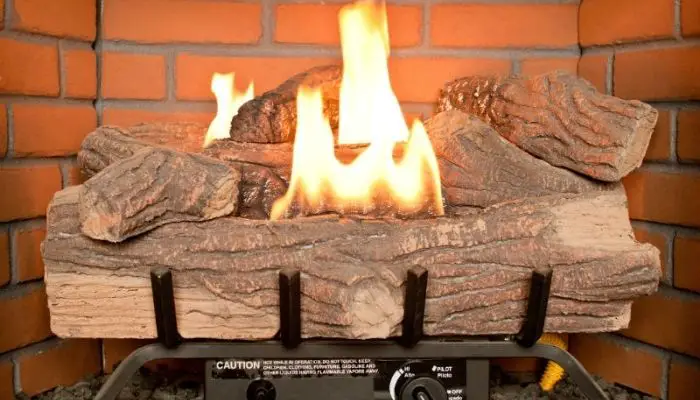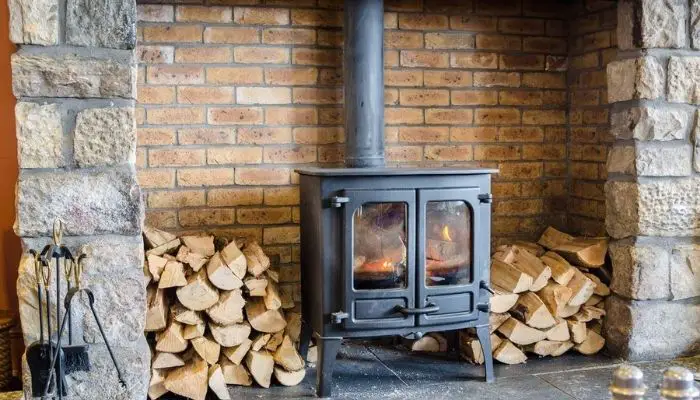No!!! Physics does not allow you to vent a wood-burning fireplace horizontally. Hot air, smoke, and fumes are light and rise due to the cold air drawn in to continue with combustion. Horizontal venting will make smoke and other fumes accumulate in the room and lead to chimney blockage.
However, pellet burning stoves can be vented horizontally or vertically through the roof. We can deduct that the type of fuel in the stove will determine how you install the vents. The horizontal venting system can also work on gas fireplaces. The insert stoves are connected to the existing chimney using a horizontal pipe.
To drive the point home, we have to look at the different venting systems for fireplaces.
Types of Venting Systems For Fireplaces
Direct -vent
This is a contained venting system whereby fresh air from outside is drawn in to support combustion while fumes are expelled. A separate chamber with an electric fan blows warm air back into the room. All fumes and smoke are expelled through an exhaust pipe installed in the system.
Most direct vent systems have a glass screen in front of the fireplace. This system will ensure you have clean air in your home because 90% of the fumes are expelled outside. It is also an efficient system that provides all heat in your home. This is why many modern homes have this type of vent.
Natural vent/B-vent
This venting system draws air for combustion from inside the room, and fumes are released through the chimney. The chimney is installed directly through the roof. They are cheap to install but less efficient. You must have gas sensors to prevent excess backflow of toxic gases. The best thing is how this system gives a wonderful glow of natural flames.
Why and How to Clean a Fireplace Chimney
Burning wood produces smoke and creosote that sticks on the sides of the chimney. Rodents and birds can also live in the chimney making it dirty. Creosote and other organic material can be flammable hence dangerous for your property. It is important to clean your chimney once in a while. But how do you clean the chimney? Below is how to clean a chimney with simple tools.
What you need
– Chimney brushes
– Extension glass
– Vacuum cleaner
– Flashlight
– Plastic sheets
– Duct tape
– Dust mask
– Screwdriver
– A ladder
Step 1. Measure the size of your fireplace and cut a piece of plastic sheet that fits the space. Use duct tape to hold the plastic sheet in place. Doing so will prevent soot and creosote from entering the room. Ensure the damper is fully open.
Step 2. Place the ladder against the wall and use it to climb on top of the roof. Bring your cleaning tools, including the dust mask.
Step 3. Use the screwdriver to remove the chimney cap, and you can use the cordless drill if the screws are too tight. Ensure you place the cap at a safe distance to avoid kicking it while moving around.
Step 4. Now attach the chimney cleaning brush to the first extension rod and keep other rods nearby.
Step 5. Start scrubbing the chimney downwards; continue adding the extension rods as you move down. Stop scrubbing when you reach the smoke shelf and inspect what you are doing using a flashlight.
Step 6. Remove the chimney brush, and experts recommend scrubbing it up and down as you pull the brush out. Unscrew the extension rods when you reach the joining point. Finalize the roof operations and replace the chimney cap. Collect your tools and go back to the firebox.
Step 7. Wait about 15 minutes for the dust to settle, and remove the plastic sheet covering the firebox. Then clean all reachable areas of the chimney from down. Ensure you have the dust mask and use the same cleaning tools.
Step 8. Use a vacuum cleaner to suck up all the dirt and debris. Make sure you follow the local regulations for disposing of creosote.
Chimney Maintenance Tips
1. Waterproof your chimney
Water can easily damage your chimney, and the excess moisture can weaken the brick and cement in the structure. Make sure the chimney cap does not have holes, and you can add a plastic sheet to reinforce the waterproofing. Also, add some water sealant powder to keep away the little moisture in the chimney.
2. Always clean the chimney
Your chimney will stay for long and be safer when you do a periodic cleaning. Professionals recommend you sweep the chimney at least once in three months. A dirty chimney can easily block, causing a backflow of dangerous gases. However, the more you use the fireplace, determines how frequently you should clean your chimney.
3. Professional inspection
Call a professional to inspect your chimney at least once a year. An expert will recognize an issue before it develops into a disaster. Some companies offer inspection services and other necessary services like cleaning. This is an expensive option but will add to the useful life of your chimney.
Conclusion
In conclusion, you cannot vent a wood-burning fireplace horizontally. The chimney should go vertically through the roof. This is because the warm fumes and smoke are lightweight and will rise. Dangerous gases and smoke will accumulate in the room if you vent the wood-burning fireplace horizontally.


